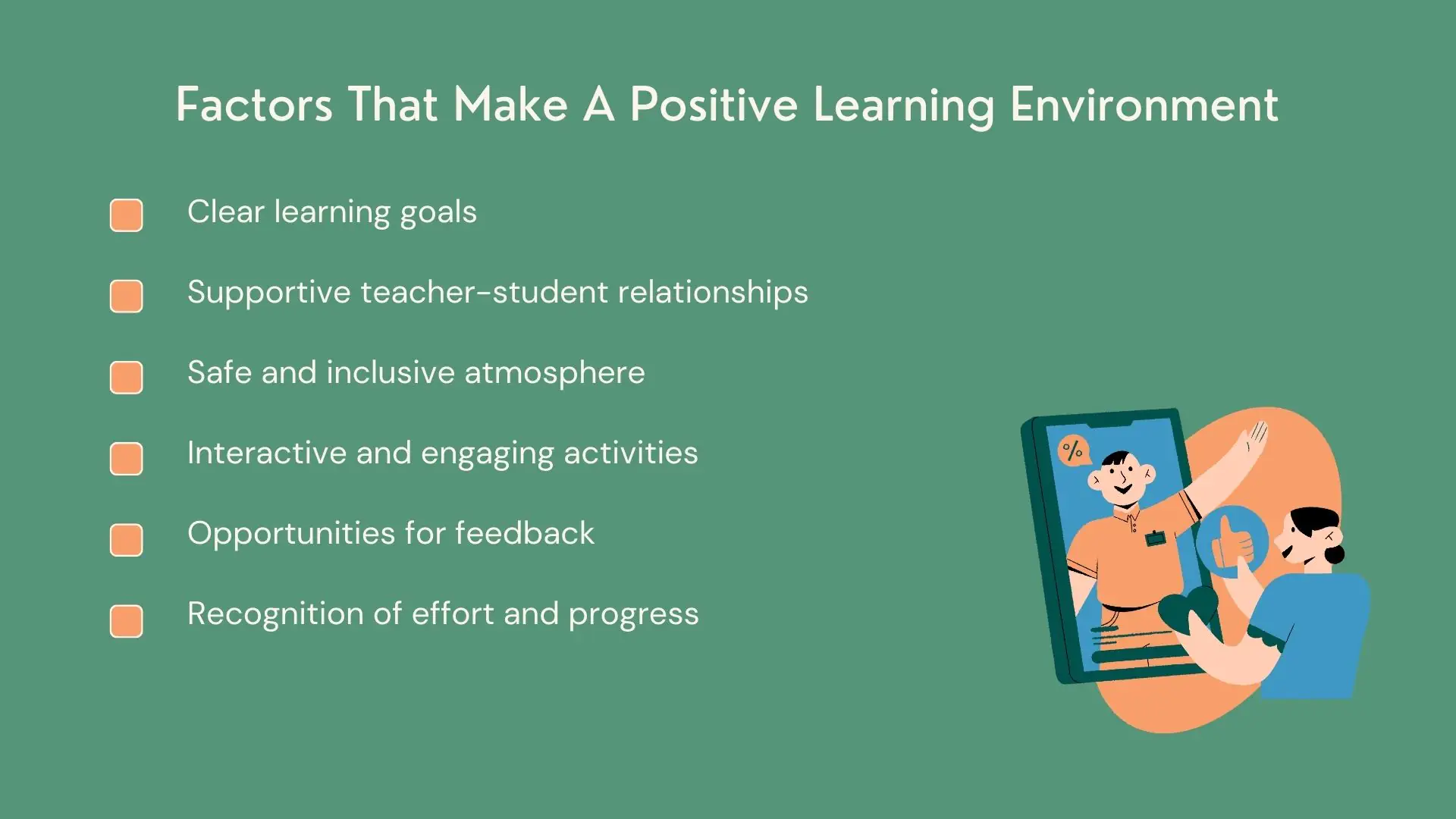Whether in schools, universities, or the corporate world, a good learning environment sets the stage for lifelong success. Supportive and positive learning environments lead to better attendance, increased grade promotions, and higher graduation rates. Recent meta-analyses confirm that the quality of both school and classroom climate is one of the strongest predictors of student achievement!
Simple adjustments to physical and emotional conditions, like adding natural light or dedicated reflection spaces, can translate into test-score gains of three to seventeen percent over just one academic year.
It’s more than comfy chairs and bright lighting — an effective learning environment weaves physical, emotional, and psychological elements so learners feel safe, supported, and ready to explore. When desks are arranged for collaboration and feedback flows freely, knowledge takes root more deeply.
“Today’s learners aren’t after endless lectures or cookie-cutter course formats. They want room to tinker with ideas, ask the “stupid” questions, and build real skills. A truly positive learning environment gives them that permission slip: a place — online or off — where mistakes become growth moments, curiosity sparks community, and every voice matters.” — Raccoon Gang’s EdTech Architect
What Is a Learning Environment?
An effective learning environment refers to the combination of physical, social, emotional, and digital factors where education happens. It covers everything from classroom layout and furniture to social dynamics between instructors and learners. It also includes the technology platforms that support instruction. When educators focus on these elements, they create a space for meaningful engagement, clear communication, and better knowledge retention.
In contrast to traditional classroom settings, where instruction happens face-to-face in a fixed space, modern environments blend online and offline education spaces, making digital tools and virtual classrooms just as important. Creating an appropriate learning environment today means designing both in-person and screen-based experiences that feel seamless, inclusive, and supportive. When done well, learners thrive because the right mix of safety, encouragement, and challenge is in place.
While building a gamified LMS for a nationwide youth education initiative, we learned how critical elements of a learning environment are — things like instant badge rewards, clear progress rules, and mobile-optimized content. In just four months, our 11-developer team onboarded over 7,000 learners, logged 1,000 billed hours, and saw 80 percent of visits engage deeply with interactive modules.
That jump in engagement and a tenfold increase in issued certificates prove that elements of a learning environment built around gamification, live feedback, and other student engagement strategies make learning stick.
Elements of a Positive Learning Environment
- Safe and accessible physical space
- Psychological safety and trust
- Emotional support and encouragement
- Opportunities for peer interaction and collaboration
- Integration of interactive technology and digital platforms
- Clear goals and constructive feedback
- Flexibility to accommodate diverse learning needs.
This comparison shows how traditional models emphasize structured face-to-face time, while modern environments prioritize adaptability, technology integration, and continuous feedback — key factors for effective learning today:
| Aspect | Traditional Learning Environment | Modern Learning Environment |
| Delivery Method | In-person classroom instruction | Blended learning with virtual classrooms and eLearning modules |
| Physical Space | Set seating and fixed schedules | Flexible seating, breakout areas, and online collaboration hubs |
| Technology | Chalkboard, overhead projector | Interactive whiteboards, simulators, and mobile-ready courses |
| Interaction | Teacher-led lectures and student Q&A | Peer-led forums, live polling, and role-playing simulations |
| Assessment | Periodic exams and quizzes | Continuous checks with digital quizzes, analytics dashboards |
| Flexibility | Fixed timetable, slow schedule changes | On-demand microlearning, self-paced modules, and real-time updates |
Why Is a Positive Learning Environment Important?
Student Motivation
When learners feel genuinely respected by teachers who listen and by classmates who support them, the spark to dive into new challenges lights up. A positive learning environment prioritizes comfort. Details like non-creaking chairs, a pleasant room temperature, soft yet bright lighting, and easy access to supplies are key. These elements collectively send the clear message: “You matter here.” Studies show that when these elements of a learning environment are in place, students report feeling 30 percent more driven to engage and explore on their own terms.
Behavior
Clutter and confusion are concentration’s worst enemies. An orderly space where materials are stocked, posters guide attention, and pathways are clear sets a calm tone that helps everyone stay on task. Pair that with a consistent, respectful routine, and you’ve built a learner-centered approach that quietly nudges people toward positive choices. When expectations and resources line up, off-topic chatter and disruptions become the exception, not the rule.
Participation
Nothing beats the buzz of a room where every voice is welcomed. A learner-centered approach means designing activities — think small-group debates, peer-led workshops, and digital forums — that welcome diverse viewpoints and hands-on problem solving. By arranging seating in circles, posting thought-provoking prompts, and keeping tech tools at everyone’s fingertips, participation can rise by as much as 40 percent. That social and emotional engagement is a trademark of effective learning environments.
Outcomes
At the end of the day, these intentional touches pay real dividends. Schools and businesses report up to a 25 percent drop in absences and a substantial decrease in dropout risk when physical comfort, emotional safety, and psychological trust come together. Learners in these settings don’t just memorize facts — they sharpen critical thinking, boost collaboration skills, and carry a love of learning into whatever comes next.
Examples of Positive Learning Environments
Based on our experience with many customers, we’ve sketched out three scenarios that show how ordinary learning settings can become truly inclusive, motivating, and dynamic. Each illustrates how collaborative learning spaces and flexible learning environments work together to support curiosity, confidence, and connection.
A STEAM Innovation Lab in a High School Setting
In a high school STEAM lab built around Open edX® Services, collaborative learning spaces appear at every turn:
- Teams huddle around 3D‐printing stations, share progress on live LMS dashboards, and brainstorm on digital whiteboards.
- Movable tables and stools create flexible learning environments, shifting instantly from hands‐on build areas to quiet coding corners.
- Custom xBlocks display student work on large screens. Peer review sessions take place in pop-up chatrooms. This mix of physical comfort and smart tech sparks curiosity and keeps young innovators engaged.
- By combining comfortable seating, ample supplies, and a learner-centered approach, with instructors facilitating rather than lecturing, thanks to instructional design services, the lab boosts curiosity and keeps young innovators engaged.
A Corporate Training Studio
Imagine a corporate studio where employees rotate through scenario simulations, group workshops, and microlearning pods — all orchestrated via a customized Open edX backend and organized digitally thanks to online course development services:
- Collaborative learning spaces here include modular seating clusters wired for video calls and interactive displays that sync with real-time RG Analytics reports.
- Adjustable lighting, sound zones, and rolling presentation carts deliver flexible learning environments that adapt to workshops, hackathons, or one-on-one coaching.
- Instant quizzes, guided demos, and “learn-by-doing” labs ensure professionals practice new skills immediately, then refine them with targeted feedback.
- This arrangement demonstrates an effective learning environment as the LMS integrates real-time analytics with physical adaptability, enabling professionals to practice new skills in authentic scenarios and receive instant feedback.
A Fully Virtual Open edX Academy
A fully online academy can still feel personal. In this space, collaborative learning spaces take shape in virtual breakout rooms, peer-review forums, and live coding duels:
- Learners choose between self-paced micro-modules, instructor-led webinars, and scenario-driven story-based animations, switching modes without losing progress.
- These flexible learning environments extend to mobile apps with offline access, so geography or signal strength never stalls momentum.
- Custom educational mobile app support ensures offline access to how-to videos, interactive labs, and story-based animations, so geography never hinders participation.
- By blending social interaction, gamified badges, and rich analytics, the platform sustains motivation and drives real-world skill mastery.
Tips on How to Create a Positive Learning Environment
When creating an appropriate learning environment that feels warm and engaging, focus on both structure and freedom so everyone knows the path forward and feels invited to explore off the beaten track.
“When we design a course, our first step is to map a clear learning roadmap in the LMS so that every learner knows exactly what the next goal is and can track their progress. Then we layer in open-ended projects and real-world scenarios that let people follow their curiosity and bring their ideas to life. That mix of structure and creative freedom keeps motivation high and makes sure every voice has a chance to be heard and valued.” — Raccoon Gang’s EdTech Architect
Embrace inclusive teaching practices by making room for every learner’s voice:
- Co-create the rules: Invite learners to help set expectations. When people decide together how to work and play, they take ownership of the space and hold each other accountable.
- Build in moments of collaboration: Arrange chairs in small circles or use your digital platform to create breakout rooms. Simple shifts let learners tackle problems side by side, share feedback, and feel part of a team.
- Offer thoughtful feedback: Notice effort and improvement as often as you highlight mastery. A quick note—“I saw how you tried a new approach; next time you might…” — shows you care about their growth.
- Mix up the furniture: Provide stools for quick check-ins, lounge cushions for brainstorming, and standing desks for bursts of energy. Let people choose what feels right for the moment.
- Invite everyone to speak: Use pulse checks, chat polls, or a virtual “talking stick.” Small prompts, such as “What part surprised you today?” give quieter learners a comfortable way in.
- Use a variety of tools: Blend short videos, story-based animations, hands-on experiments, and mock simulations. Catering to different styles makes the learning environment more dynamic and inclusive.
Emotional Support and Positive Atmosphere
Emotional support in education isn’t a checklist item — it’s the spark that turns uncertainty into confidence and turns classrooms into communities. In a truly positive learning environment, a simple “How are you today?” or “I saw how hard you worked on that” does more than fill seats; it lets learners know they matter.
When respect and kindness color every interaction, anxiety fades, curiosity blooms, and every stumble becomes a chance to learn rather than a moment of shame.
Ways to weave emotional support into your day:
- Carve out time for genuine one-on-one check-ins, simply to listen and validate concerns.
- Begin each session with a short breathing or grounding exercise to settle nerves.
- Celebrate effort as much as achievement—send a quick LMS badge or shout-out for perseverance.
- Choose inclusive language that honors diverse backgrounds and perspectives.
- Frame feedback around strengths first, then offer clear, helpful next steps.
- Designate a quiet corner or virtual “cozy room” where learners can recharge or seek private support.
- Pair learners in peer-mentoring buddies so they can cheer each other on.
- Share simple self-care tips and mental-health resources to normalize well-being conversations.
- Build in flexible deadlines when life happens, showing empathy for personal challenges.
- Model your own learning journey: share moments when you struggled and how you overcame them.
The Final Conclusion
We’ve explored what transforms ordinary spaces into places of discovery. Thoughtful layouts say “you belong.” Emotional support says, “you can.” And tech tools spark the question, “What if?”
When combined, these elements create an effective learning environment. It’s a space where curiosity grows, participation increases, and results follow. Just ask NASA, where our Open Science 101 curriculum brought hands-on modules and real-time analytics to thousands of researchers, or Harvard, where tailored leadership programs on Open edX have helped executives learn on their own terms. Let’s bring your ideas and our resources together to see what’s possible:
- LMS customization and development on Open edX to align every interface and workflow with your brand and learning goals.
- Mobile course delivery with offline support, so learners can stay engaged wherever they are.
- Gamification and interactive simulations that keep motivation high and reinforce real-world practice.
- Deep analytics integration to track progress, pinpoint gaps, and inform continuous improvement.
- Multimedia content design, from video how-tos to story-driven animations and hands-on labs, speaks to every learning style.
→ Reach out today, and let’s build the learning environment your team deserves.





